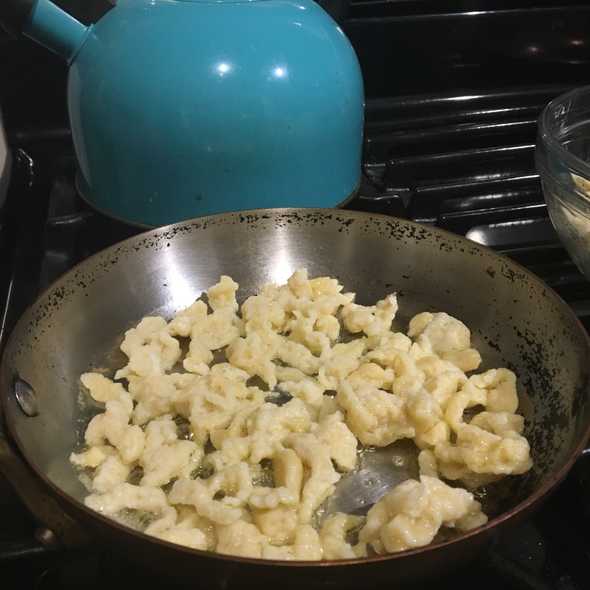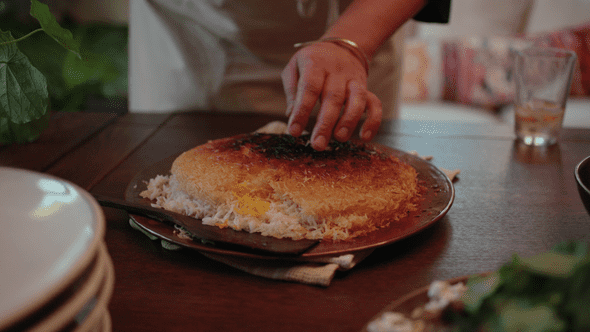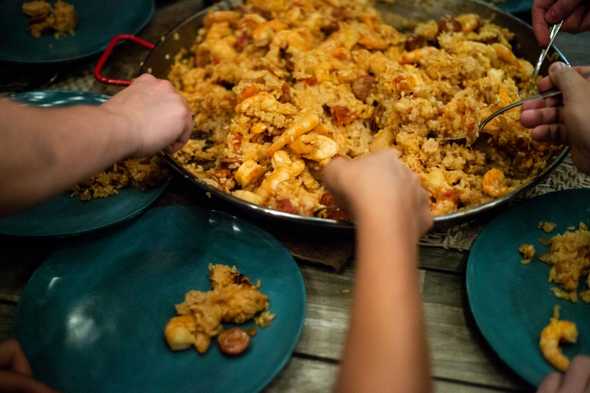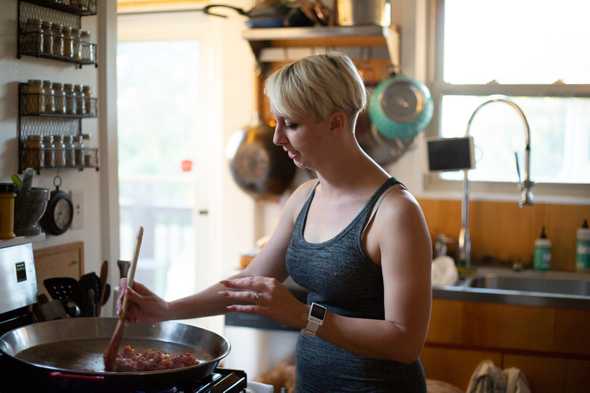Paella de Casa Wadella
This post was inspired by an incident my friends and I now refer to as #chorizogate. After various requests on twitter, here is how I cook paella.
August 07, 2019
This post was inspired by an incident my friends and I now refer to as #chorizogate. I had just gotten a new paella pan + burner and after a great test run, delicious paella, and much wine with friends I drunkenly tweeted this then promptly passed out:
I woke the next morning to a ton of likes and retweets, and some very irate dudes who were telling me it’s not “paella” because I put chorizo in it. So let’s back up a bit to discuss how we got here.
My Foodie Journey
I grew up in a middle class American household where food wasn’t celebrated, it was something put on the table by my hardworking parents in between school, work, and excessive marching band practices. We ate well, and the food was tasty, but it cooking it was more of a task than experience. I grew up in the suburbs and my friends liked to go to places like iHop and Applebees, and I think even then being a foodie must have been in my blood because I was so quickly bored with these menus and always tried something new or ordered the most interesting thing I could find on the menu.
During this time I could NOT cook, it wasn’t a skill I tried to learn and my mother joked I could burn boiling water. I didn’t really start cooking until my college boyfriend got me into it. Cooking was his passion and somehow made it less intimidating for me to attempt. After we broke up I continued cooking for myself and spent more and more time trying new recipes, learning about wine, and flexing my experimental chef muscles. I loved pasta and quickly fell in love with creating my own sauces from scratch and to this date few things make me happier than the thickening of a roux I created from scratch in anticipation of transforming it into a rich, creamy alfredo sauce or to make biscuits and gravy.
Fast forward to a decade later, I’m quite accomplished in the kitchen, have a penchant for restaurants offering Chef prix fixe menus, am an adventurous wino, on first name basis with the guys at my nearby butcher shop, and have traveled the world and collected cookbooks from every culture along the way. I’ll get intrigued by something I encounter or read about, be it the perfect chimichurri sauce, fluffy gnocchi from scratch, poke bowls, chicken paprikash, sweet soft bao buns, or lobster bisque(with stock from scratch of course), furiously research the origins and history of the dish, read various cooking methods and approaches, track down exotic spices and ingredients, then cook the dish over and over until I’m happy with the results. When I got back from Budapest last year, I made späetzle from scratch several weeks in a row until I got it right.

Perhaps because of my own lack of cultural upbringing as a melting-pot suburban raised American, I am always fascinated by the history of dishes, what led to their creation, and the way food ideas transcend cultures and even different households. I love knowing the traditional approaches, and then taking my own spin on them - like adding gratuitous fresh dill to the dumplings in chicken & dumplings.
My venture into cooking Paella was no different, I became fascinated, I set about researching, acquiring various cookbooks, and researching the origin and different types of the dish. When it came time to prepare the dish for the first time, I didn’t even bother with my largest Mauviel saute pan, I went straight to the internet and bought an authentic 20” paella pan.
Paella History
Paella is a dish, that like many dishes in different cultures was created to feed a large amount of people cheaply - originally farmers or workers during lunch. They would cook the paella for a large group of people over open flames in a large pan. Ingredients varied by what were cheap and accessible by region, but the method cooking method was the same. To me, the most enticing thing was the attention to layering of flavors and texture of the rice. Paella is mostly credited to the Valencia region in Spain, and has grown out from there in variety of ingredients and style.
There are two main styles of paella - a drier paella or a more soupy paella, but they are both comprised by few key components:
- Sofrito - the flavor base of many hispanic dishes, typically consisting of tomatoes, onion, and pepper.
- Spices - a mix of salt, paprika, and those beautiful red saffron threads that carry such a deliciously fragrant yet earthy aroma.
- Rice - bomba is the shortgrain rice used in authentic Paella dishes, and is cooked using stock.
- Meat - regional ingredients added to give the dish protein.
The style of paella I was most drawn to was a drier rice dish with the vied after-socarrat: a crispy layer of perfectly caramelized rice at the bottom of the dish. This desirable texture is found in more than just paella, like the Persian-ish Rice with Tahdig Samin Nosrat talks about her mother cooking just right.

Perfecting the socarrat is still a skill I’m working on nailing every time I cook paella, and the times when I get it right it’s so damn good - like it was on the night of my infamous tweet.
Sofrito
When cooking in the summer I get my hands on delicious heirloom tomatoes that are so readily available. In the winter I opt for the big cans of crushed, peeled tomatoes - they’ll have more flavor than the out-of-season ones you’ll find at the grocery store. I use garlic in place of onions for a drier paella dish - the water in the onions contain can water the softiro down too much. I also love to add a diced poblano pepper, I feel like the poblano adds spice and depth of flavor without overpowering the sofrito.
Sofrito can also be made ahead of time and stored for later, which is something I do when I’m prepping for a paella dinner party or when the tomatoes are too good and I go a little nuts murdering them to make sauces to store away for the winter.
Spices
Salt. Kosher.
Paprika.
Saffron. It’s expensive but so worth it. I used all the cash I had in Barcelona to bring back a decent stockpile.
If you’re new to cooking, I urge you to skip the expensive McCormicks shit at the grocery store and look for local farmers markets or ethnic markets in your area. You’ll be able to buy in bulk for way cheaper and the quality will be better and the spices fresher!
Rice (& broth)
I’ve cooked with both Bomba and Abrorio rice, and I honestly prefer Abrorio. It’s cheaper and easier to acquire and I like the texture more. You may recognize it from dishes like “risotto”. When preparing paella, you measure rice per person you’ll be serving, 1/3 to 1/2 cup of dry rice per person. For every cup of rice you’ll need 2 1/4 cups of both.
| People | Rice (cups) | Broth (cups) |
|---|---|---|
| 6 | 3 | 6 3/4 |
| 12 | 6 | 13 1/2 |
| 18 | 9 | 20 1/4 |
Protein
Some may say the most traditional paella is made with only rabbit and snail, but paella cooked closer to the ocean is often prepared with mussels and other accessible seafood.
For my paella I typically add shrimp and sliced chorizo, but not just ANY chorizo - cooking chorizo from Broadway Butcher. It’s not overpowering in flavor but has an amazing smokiness that complements the dish perfectly.
My Paella Setup
- paella pans
- cooking ring/burner
- wooden spatula
- arborio rice
- unsalted chicken or vegetable stock from Amazon/Costco
Jennifer’s Paella
Now, I present to you how I prepare paella - “Paella de Casa Wadella” - internet randos be damned!

Ingredients
- Fuckton of olive oil - the good stuff. (watch this episode of Salt, Fat, Acid, Heat)
- 1-2 large heirloom tomatoes. The weirder looking the better. If it’s not tomato season, canned skinless diced tomatoes will work just fine.
- 3-4 cloves of garlic - or as the meme says “you measure that shit with your heart”
- 1 poblano pepper
- Salt
- Paprika
- Saffron
- Abrorio rice based on individuals served(this sofrito amount is for about 10 people)
- Unsalted chicken stock based on individuals served + 1-2 cups extra
- Uncooked, peeled, deveined shrimp
- Cooking chorizo from Broadway Butcher
Instructions
- Prep ingredients. Dice the garlic and set aside. Dice the poblano and set aside. For the tomatoes - I like to cut to remove the stem, then cut them in half and grate the tomato using a cheese grater until - I’m left with just the skin which I discard.
- Prepare the sofrito. Heat olive oil in paella pan on medium heat and saute the garlic, but don’t let it burn. Once the garlic is golden and fragrant, add the poblano and cook for 3-4 minutes. Next add the grated tomato. Cook mixture until 80% of the water has been reduced and mixture is more “jammy” in texture.
- Bloom the saffron by placing the threads in 1/2 cup of very warm water.
- Season the sofrito with salt, generous amount of paprika, and bloomed saffron(pouring the water + threads in is fine, the water will evaporate). Sorry kids, I don’t strictly measure anymore, but ballpark a tablespoon of paprika? Salt to taste, so I can’t help you there BUT do know that salt brings out the flavors of other foods, so keep that in mind if you’re a hesitant salter. Seriously, just go watch all of Salt, Fat, Acid, Heat on Netflix, it’ll change your life.
- Add more olive oil to pan then add rice, stirring to coat in olive oil and sofrito.
- Add stock to pan, salt more if necessary, stir briefly to mix and distribute rice, refill your glass of wine, and DON’T TOUCH THE DAMN SPOON AGAIN. Seriously, the one thing about rice in paella is that you don’t touch it after that initial mix or you will end up with a mushy risotto.
- When rice has ALMOST absorbed all liquid, add the shrimp and chorizo to the top of the rice.
- Watch and listen to the paella like a hawk. It’s ok to yell at your guests to shut the eff up during this part. You want the rice at the bottom of the pan to caramelize and get a little crispy without burning it. You’ll be able to hear the crackle of the rice and smell the caramelization.
- Remove pan from heat and place in front of your guests. Hand out spoons and instruct them to scoop from the pan, cause you just cooked them a delicious ass meal and don’t have time for dishes.
Vegan Paella
For vegan paella follow the recipe as above, but swap vegetable stock for the chicken stock. I don’t often see vegetable salt that’s unsalted, so be sure to season accordingly so you don’t oversalt your dish. Obviously don’t add the shrimp or the chicken, and check your local health food store for interesting protein substitutes. Pulled jackfruit could be good, or I grab vegan chorizo from Whole Foods, and if someone named Billy is around, make sure his dumb ass doesn’t eat the cut up vegan chorizo thinking they’re brownie bites.
In my opinion the protein doesn’t matter as much as the flavors you get from a good sofrito and the texture from the perfect socarrat.
Be Adventurous in Your Cooking

I love food. I love cooking food. I love eating food. I love talking about cooking and eating food. I don’t know what level cook you are, but I hope I’ve inspired you to attempt cooking your own paella, and exploring more foods and cooking styles than you have in the past! Bon appetit, and remember, don’t feed the internet trolls!
